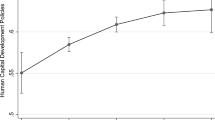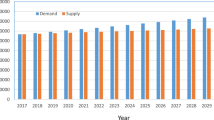Abstract
Background
Inequitable representation in journal editorial boards may impact women’s career progression across surgical, anesthesia, and obstetric (SAO) specialties. However, data from Latin America are lacking. We evaluated women’s representation on editorial boards of Latin America SAO journals in 2021.
Methods
We conducted a cross-sectional analysis, retrieving journals through Scimago Journal and Country Rank 2020. Journals were included if active, focused on SAO topics, and publicly provided information on editorial board staff. Editorial board member names and positions were extracted from journals’ websites. Members were classified into senior (e.g., editor-in-chief), academic (e.g., reviewer), and non-academic roles (e.g., administrative office). Women’s representation was predicted from first names using Genderize.io. The number of women SAO physicians per country was obtained from articles and governmental reports.
Results
We included 19 of 25 identified journals and analyzed 1,318 names. Three anesthesiology, seven obstetric, and nine surgical journals represented five Latin American countries. Women held 17% (224/1,318) of board positions [p < 0.0001; 95% CI(0.14, 0.19)]. Women held fewer academic roles (14.3%, 155/1,084) compared to senior [28.9%, 64/221 (p < 0.001)] and non-academic roles [38.4%, 5/13 (p = 0.042)]. Surgical journals had fewer women (7.7%, 58/752) compared to anesthesia [25.5%, 52/204 (p = 0.006)] and obstetrics [31.5%, 114/362 (p < 0.001)]. Women's proportion on editorial boards increased according to the number of women SAO physicians per country (p < 0.001).
Conclusions
Our study assessed the composition of editorial boards from Latin America SAO journals and demonstrated that women remain underrepresented. Our findings highlight the need for regional strategies to advance women’s careers across SAO specialties.




Similar content being viewed by others
Data availability
All data generated or analyzed are included in this published article.
References
Gottlieb M, Krzyzaniak SM, Mannix A et al (2021) Sex distribution of editorial board members among emergency medicine journals. Ann Emerg Med 77:117–123. https://doi.org/10.1016/j.annemergmed.2020.03.027
Ng-Kamstra JS, Greenberg SLM, Abdullah F et al (2016) Global surgery 2030: a roadmap for high income country actors. BMJ Glob Health 1:e000011. https://doi.org/10.1136/bmjgh-2015-000011
Gallivan E, Arshad S, Skinner H et al (2021) Gender representation in editorial boards of international general surgery journals. BJS Open:zraa064. https://doi.org/10.1093/bjsopen/zraa064
Jagsi R (2008) The representation of women on the editorial boards of major medical journals: a 35-year perspective. Arch Intern Med 168:544. https://doi.org/10.1001/archinte.168.5.544
Zhuge Y, Kaufman J, Simeone DM et al (2011) Is there still a glass ceiling for women in academic surgery? Ann Surg 253:637–643. https://doi.org/10.1097/SLA.0b013e3182111120
Babic A, Hansez I (2021) The glass ceiling for women managers: antecedents and consequences for work-family interface and well-being at work. Front Psychol 12:618250. https://doi.org/10.3389/fpsyg.2021.618250
Fox CW, Duffy MA, Fairbairn DJ, Meyer JA (2019) Gender diversity of editorial boards and gender differences in the peer review process at six journals of ecology and evolution. Ecol Evol 9:13636–13649. https://doi.org/10.1002/ece3.5794
D’Armiento J, Witte SS, Dutt K et al (2019) Achieving women’s equity in academic medicine: challenging the standards. The Lancet 393:e15–e16. https://doi.org/10.1016/S0140-6736(19)30234-X
Clark J, Horton R (2019) What is The Lancet doing about gender and diversity? The Lancet 393:508–510. https://doi.org/10.1016/S0140-6736(19)30289-2
Bissing MA, Lange EMS, Davila WF et al (2019) Status of women in academic anesthesiology: a 10-year update. Anesth Analg 128:137–143. https://doi.org/10.1213/ANE.0000000000003691
Dada S, van Daalen KR, Barrios-Ruiz A et al (2022) Challenging the “old boys club” in academia: gender and geographic representation in editorial boards of journals publishing in environmental sciences and public health. PLOS Glob Public Health 2:e0000541. https://doi.org/10.1371/journal.pgph.0000541
Aquino-Canchari CR, Chávez-Bustamante SG, Benites-Ibarra CA et al (2022) Participación femenina en los comités editoriales de revistas médicas en Latinoamérica. Biomedica 42:355–363. https://doi.org/10.7705/biomedica.6120
von Elm E, Altman DG, Egger M et al (2007) Strengthening the reporting of observational studies in epidemiology (STROBE) statement: guidelines for reporting observational studies. BMJ 335:806–808. https://doi.org/10.1136/bmj.39335.541782.AD
Scimago Journal & Country Rank. https://www.scimagojr.com/. Accessed 16 Apr 2022
SJR—About Us. https://www.scimagojr.com/aboutus.php. Accessed 24 Oct 2022
SJR Country Graphs. https://www.scimagojr.com/countrygraph.php?year=2021®ion=Latin%20America. Accessed 24 Oct 2022
Ferreira J, Bowder AN, Faria I et al (2022) Evolution of gender disparities among brazilian surgical, anesthesia, and obstetric providers. J Surg Res 275:1–9. https://doi.org/10.1016/j.jss.2021.12.045
Meara JG, Leather AJM, Hagander L et al (2015) Global Surgery 2030: evidence and solutions for achieving health, welfare, and economic development. The Lancet 386:569–624. https://doi.org/10.1016/S0140-6736(15)60160-X
New World Bank country classifications by income level: 2021–2022. https://blogs.worldbank.org/opendata/new-world-bank-country-classifications-income-level-2021-2022. Accessed 24 Oct 2022
Heidari S, Babor TF, De Castro P et al (2016) Sex and gender equity in research: rationale for the SAGER guidelines and recommended use. Res Integr Peer Rev 1:2. https://doi.org/10.1186/s41073-016-0007-6
Genderize.io|Determine the gender of a name. https://genderize.io/. Accessed 16 Apr 2022
Hart KL, Perlis RH (2019) Trends in proportion of women as authors of medical journal articles, 2008–2018. JAMA Intern Med 179:1285. https://doi.org/10.1001/jamainternmed.2019.0907
DeFilippis EM, Sinnenberg L, Mahmud N et al (2021) Gender differences in publication authorship during COVID-19: a bibliometric analysis of high-impact cardiology journals. J Am Heart Assoc 10:e019005. https://doi.org/10.1161/JAHA.120.019005
Scheffer M (2020) Demografia Médica no Brasil. FMUSP, CFM, São Paulo, SP
Anuario Estadístico de Salud 2020|SITEAL. https://siteal.iiep.unesco.org/bdnp/3974/anuario-estadistico-salud-2020. Accessed 20 Jun 2022
Departamento de Estadisticas e Información de Salud. https://deis.minsal.cl/. Accessed 20 Jun 2022
Heinze-Martin G, Olmedo-Canchola VH, Bazán-Miranda G, Bernard-Fuentes NA, Guízar-Sánchez DP (2018) Los médicos especialistas en México. Gac de Méx 154:555. https://doi.org/10.24875/GMM.18003770
Histórico de alterações do QGIS 2.18. https://qgis.org/pt_BR/site/forusers/visualchangelog218/index.html. Accessed 20 Jun 2022
Graham JW (2009) Missing data analysis: making it work in the real world. Annu Rev Psychol 60:549–576. https://doi.org/10.1146/annurev.psych.58.110405.085530
Nafade V, Sen P, Pai M (2019) Global health journals need to address equity, diversity and inclusion. BMJ Glob Health 4:e002018. https://doi.org/10.1136/bmjgh-2019-002018
Caribbean EC for LA and the (2017) Member States and associate members. https://www.cepal.org/en/about/member-states. Accessed 9 Jul 2022
Knaul FM, Arreola-Ornelas H, Essue BM et al (2022) The feminization of medicine in Latin America: ‘more-the-merrier’ will not beget gender equity or strengthen health systems. Lancet Reg Health Am 8:100201. https://doi.org/10.1016/j.lana.2022.100201
Hinsley A, Sutherland WJ, Johnston A (2017) Men ask more questions than women at a scientific conference. PLoS One 12:e0185534. https://doi.org/10.1371/journal.pone.0185534
Harris CA, Banerjee T, Cramer M et al (2019) Editorial (spring) board? Gender composition in high-impact general surgery journals over 20 years. Ann Surg 269:582–588. https://doi.org/10.1097/SLA.0000000000002667
Boniol M, McIsaac M, Xu L, et al Gender equity in the health workforce: Analysis of 104 countries. 8
Ehrlich H, Nguyen J, Sutherland M et al (2021) Gender distribution among surgical journals’ editorial boards: empowering women surgeon scientists. Surgery 169:1346–1351. https://doi.org/10.1016/j.surg.2020.12.026
The Editors of the Lancet Group (2019) The Lancet Group’s commitments to gender equity and diversity. The Lancet 394:452–453. https://doi.org/10.1016/S0140-6736(19)31797-0
Roman S, Sosa JA (2022) The ombuds for diversity, equity, and inclusion as an essential addition to the WJS editorial board. World J Surg 46:973–975. https://doi.org/10.1007/s00268-022-06512-1
Scientific Journals Commit to Diversity but Lack the Data - The New York Times. https://www.nytimes.com/2020/10/30/science/diversity-science-journals.html. Accessed 23 Jun 2022
Dewidar O, Elmestekawy N, Welch V (2022) Improving equity, diversity, and inclusion in academia. Res Integr Peer Rev 7:4. https://doi.org/10.1186/s41073-022-00123-z
Metz I, Harzing A-W, Zyphur MJ (2016) Of journal editors and editorial boards: who are the trailblazers in increasing editorial board gender equality?: journal editors and editorial boards. Br J Manag 27:712–726. https://doi.org/10.1111/1467-8551.12133
Acknowledgements
We would like to acknowledge Bruna Oliveira Trindade for having contributed to geospatial mapping and data visualization. We would also like to acknowledge Fundação Maria Emília, a Brazilian nonprofit organization that fosters research projects with social impact, which has been supporting the author LNC in her academic endeavors—the funder played no role in the design, collection, analysis, interpretation, and writing of this article.
Author information
Authors and Affiliations
Contributions
LNC, AN, AGR, IF, and CVSF contributed to this study’s conceptualization. All authors have contributed to the methodology. LNC, AGR, GRB, IF, TAJP, SSS, BF, SW, and LSS collected the data. LNC and GRB managed software applications. LNC, AN, and RF formally analyzed the data. LNC and AN curated the data. AN and RF validated the reproducibility of findings. LNC, AGR, and TAJP contributed to data visualization. LNC, AGR, GRB, CVSF, SSS, and BF wrote the original manuscript draft. IF, TAJP, LSS, AN, RF, and JLF reviewed and edited the manuscript. L.N.C and A.N administered the project. RF and JLF supervised the study.
Corresponding author
Ethics declarations
Conflict of interest
All the authors declare that they have no conflict of interest.
Additional information
Publisher's Note
Springer Nature remains neutral with regard to jurisdictional claims in published maps and institutional affiliations.
Rights and permissions
Springer Nature or its licensor (e.g. a society or other partner) holds exclusive rights to this article under a publishing agreement with the author(s) or other rightsholder(s); author self-archiving of the accepted manuscript version of this article is solely governed by the terms of such publishing agreement and applicable law.
About this article
Cite this article
Campos, L.N., Naus, A., Rangel, A.G. et al. Women Representation on Editorial Boards in Latin America Journals: Promoting Gender Equity in Academic Surgery, Anesthesia, and Obstetrics. World J Surg 47, 845–853 (2023). https://doi.org/10.1007/s00268-022-06872-8
Accepted:
Published:
Issue Date:
DOI: https://doi.org/10.1007/s00268-022-06872-8




